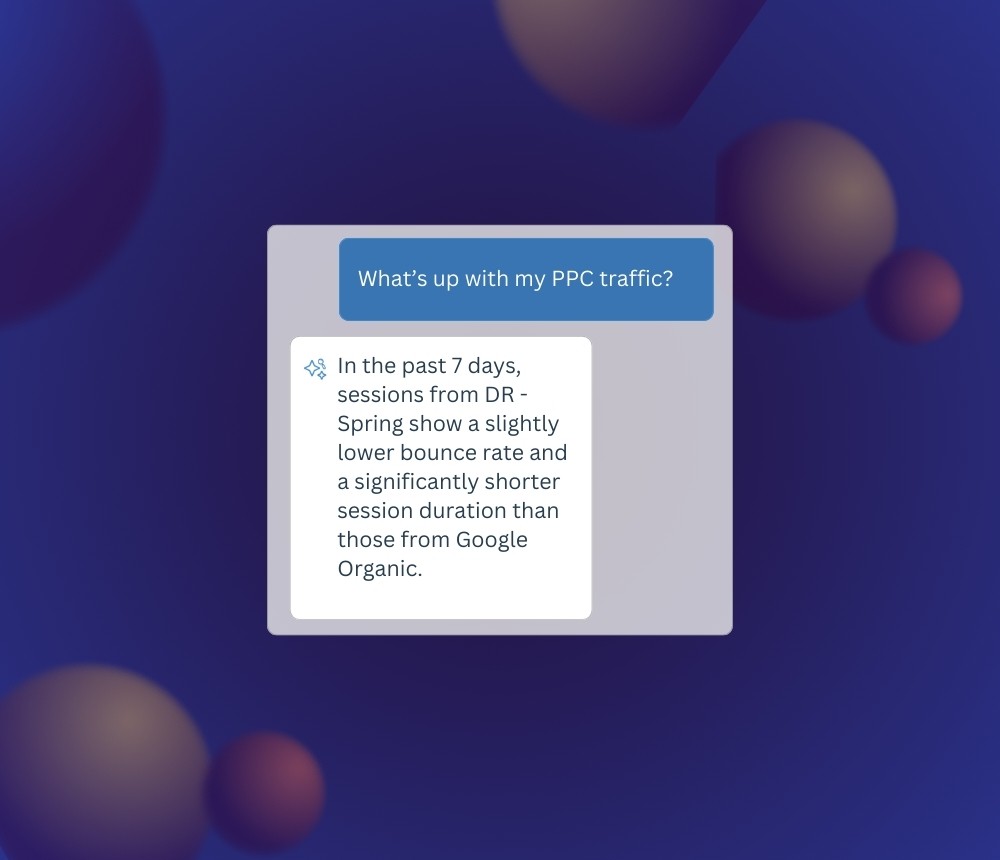How to Improve Conversion Rate: 15 Proven Strategies

How to Improve Conversion Rate: 15 Proven Strategies
If you’ve been increasing ad spend, diving into SEO or launching new marketing channels but aren’t seeing more sales, the problem isn’t traffic — it’s conversions (duh). But the real opportunity worth talking about is turning the website visitors you're already earning into paying customers.
Below are 15 proven strategies that marketers at mid-market e-commerce and lead gen businesses can use to improve their conversion rate and get more from marketing efforts. Each tactic is practical, backed by research and relevant in 2025.
1. Optimize Page Load Speed
Page load times directly impact conversions. In fact, Shopify reports that even a one-second delay can hurt conversions by up to 7%.
Slow sites drive away potential customers, especially on mobile devices. Faster sites not only convert better but also rank higher in search, which means improvements here deliver double the payoff. Even small changes like optimizing images or using browser caching can produce immediate improvements in your website’s conversion rate.
Aim for under three seconds per page: Strive to hit this benchmark across all device types by monitoring performance with tools like PageSpeed Insights. Faster load speeds lower bounce rates and create a smoother user experience.
Compress and lazy load images: Large images are one of the biggest culprits of slow sites. Use next-gen formats like WebP and lazy loading so images only load when users scroll.
Use a CDN to reduce server response: A content delivery network ensures assets load from servers geographically closer to users, cutting down on delays and creating consistency across regions.
2. Improve Mobile Optimization
A poor mobile site creates friction and obviously lowers mobile conversion rates.
Visitors expect the same smooth experience they get on desktop, and when they don’t, they leave quickly in search of a better experience. Optimizing for mobile users is no longer optional — it’s the baseline for serious websites. Investing in mobile optimization also prepares you for future updates from Google, which continues to prioritize mobile-first indexing.
Build responsive, mobile-first landing page design: Prioritize layouts that adapt seamlessly to smaller screens, with fonts, spacing and layouts optimized for readability and usability.
Make call to action buttons easy to tap: Buttons should be large enough to click comfortably with thumbs, and spaced apart to prevent accidental taps. Always use contract colors for CTA buttons.
Simplify checkout form fields for mobile users: Reduce unnecessary inputs, use autofill where possible, and break longer forms into digestible steps that fit mobile screens.
3. Strengthen Your Value Proposition on Critical Pages
Your value should be clear immediately. Customers need to understand within seconds why they should choose you over all other competitors.
If your message is vague or generic, you’ll blend into the noise and fail to stand out against competitors. Strong value propositions communicate benefits with clarity and build trust before users even scroll. Testing and refining your value proposition can be one of the most impactful ways to increase your conversion rate.
Lead with benefits, not features: Instead of highlighting specs, emphasize the problems you solve or the outcomes you deliver, like saving time or boosting revenue.
Place your value proposition above the fold on critical pages: Make sure visitors see your promise right away, without having to scroll or dig for information.
Reinforce it with social proof and authentic customer reviews: Pair your main promise with testimonials, ratings, or recognizable client logos to prove your claim isn’t just marketing talk.
4. Reduce Form Fields (where possible) to Improve the Buying Process
Long forms discourage signups. HubSpot found that cutting the number of fields from 11 to 4 increased conversions by 120%.
The fewer the fields, the lower the friction.
Visitors will abandon forms that feel like too much effort, so simplifying them pays off immediately. Think of every unnecessary field as a roadblock between your lead and your sales team. Removing them can directly boost conversions without any extra traffic.
Only request essential information: Stick to basics like name and email. If you don’t absolutely need a field, it belongs later in the sales process...not the first form step.
Use progressive profiling for lead gen: Collect more details gradually over time through repeat interactions rather than demanding everything upfront.
Break complex forms into steps: Multi-step forms reduce perceived effort. Asking three smaller questions feels less daunting than one giant form.
5. Offer Free Shipping
Ecommerce sites lose sales when extra shipping costs only appear once you reach checkout.
Offering free shipping — even if factored into pricing — reduces friction and improves ecommerce conversion rates. Shoppers expect transparency, and unexpected costs are one of the top reasons for cart abandonment. Making shipping simple can be the difference between a bounce and a sale.
Even testing thresholds like “free shipping on orders over $50” can nudge average order values higher.
Test free shipping thresholds (e.g., over $50): Offering free shipping with a minimum order value encourages customers to add extra items to their cart.
Highlight free shipping on product pages: Make it visible early in the checkout process so customers aren’t surprised at checkout.
Combine with urgency (“Free shipping ends tonight”): Use time-sensitive offers to motivate faster decision-making and reduce procrastination.
6. Build Trust with Money Back Guarantees on Product Pages
A money back guarantee reduces perceived risk. Trust signals at checkout reassure visitors and cut abandonment.
Customers want assurance that if something goes wrong, they won’t lose their money. Clear guarantees create confidence and encourage more people to complete the purchase process. This strategy is especially powerful for first-time buyers who may be hesitant to commit.
Place trust badges near call to action buttons: Security icons, SSL seals, or payment provider logos provide visual reassurance at key decision points.
Highlight guarantees on checkout pages: Display your money back policy clearly at the moment of purchase to remove doubts.
Keep the language clear and direct: Avoid legal jargon — instead, use simple language that makes the guarantee feel honest and accessible.
7. Use High Quality Images and Video
Visuals are key. And particularly for ecommerce conversion rates, a great image set can be the difference between a sale and a, "no thank you."
High quality images and explainer videos increase confidence and conversions. Shoppers can’t touch products online, so imagery needs to do the heavy lifting of communicating detail and quality. Investing in visuals is one of the simplest ways to improve ecommerce conversion rates across product pages. Video also gives you the chance to show your product in action, which builds trust and reduces returns.
Show multiple angles: Give customers a complete view with front, back, side and zoomed-in shots to mimic the in-store experience.
Use lifestyle imagery: Place products in real-life scenarios so shoppers can visualize ownership and usage.
Add product demo videos to support much higher purchase intent: A short video showing how the product works can answer questions and reduce uncertainty.
8. Add Social Proof Everywhere
Social proof shows that others trust you. Without it, credibility drops. People look to customer feedback to reduce uncertainty and validate buying decisions.
Featuring testimonials, reviews, and user generated content strengthens your message and keeps potential customers engaged. In fact, case studies and authentic reviews are often more persuasive than your own marketing copy.
Share customer testimonials and reviews: Add direct quotes from customers to demonstrate satisfaction and highlight benefits in their own words.
Use user generated content from social platforms: Show real customers using your products in everyday life to increase authenticity.
Add case studies from trusted clients: Demonstrate measurable results and outcomes, especially for B2B or service-driven businesses.
9. Streamline Your Checkout Steps
Complicated checkout processes kill conversions. Every unnecessary extra step hurts your conversion funnel. A smooth, fast checkout helps reduce cart abandonment and improves your website’s conversion rate.
Focus on speed and clarity to maximize the number of paying customers who complete the process. A well-structured checkout experience can be the difference between a completed sale and an abandoned cart.
Allow guest checkout: Don’t force account creation. Instead, give users the choice to purchase quickly without extra friction.
Offer multiple payment options: Support credit cards, digital wallets, and other modern payment methods to match buyer preferences.
Use progress indicators: Show customers how many steps remain so they feel in control and less overwhelmed.
10. Use Personalization and Retargeting
Personalization drives ecommerce conversion.
Retargeting campaigns bring back site visitors who didn’t buy. Consumers expect experiences tailored to them, and brands that deliver relevant offers see more sales. Whether through Google Ads or email campaigns, personalization builds stronger customer journeys.
Personalized experiences show customers you understand them and help build long-term loyalty.
Add product recommendations on pricing pages: Use browsing or purchase history to surface items that match their interests.
Use Google Ads to retarget site visitors: Show tailored ads to those who viewed your site but didn’t convert, reminding them of what they left behind.
Personalize campaigns based on the customer journey: Match content and offers to where the customer is in the funnel, from awareness to decision.
11. Create Compelling Landing Pages
The visual components of your landing pages build trust. Too much clutter overwhelms, too little detail leaves doubt. Strong design balances clarity and persuasion, moving potential customers toward a decision.
Design decisions should always support usability and the page’s main call to action. By testing different versions of your landing pages, you can continually refine design choices to drive better performance.
Keep each landing page focused on one goal: Avoid distractions like multiple CTAs or off-topic content that dilute the message.
Place clear CTAs above and below the fold: Give users multiple opportunities to take action without needing to search for buttons.
Include an FAQ page or section to answer objections: Preemptively address common concerns like shipping, returns, or security.
12. Offer Clear CTAs to Increase Conversions
Buttons guide users. Weak CTAs cost conversions. A good CTA reduces uncertainty and tells the visitor exactly what to do next.
Clear, action-oriented CTAs also support testing and optimization, helping you increase your conversion rate. Remember, even small wording changes can have measurable impact.
Use action verbs: Words like “Start,” “Get,” or “Claim” make CTAs more direct and compelling.
Test contrasting colors: Choose button colors that stand out from the background and draw immediate attention.
Place CTAs on key pages: Include buttons not only on landing pages but also on product pages, blog posts, and checkout steps.
13. Use Analytics Tools for Insights
We all want to be more data-driven. Analytics tools provide actionable insights that improve conversion optimization. Without measurement, you’re guessing — and guessing usually means wasted marketing dollars.
Analytics allow you to see patterns in behavior and adjust based on real evidence. Adding multiple tools ensures you’re seeing your funnel from different perspectives.
Track ecommerce conversion rates with Google Analytics (GA4): Monitor performance over time and spot where customers drop off in the funnel.
Use Lucky Orange heatmaps and recordings: See exactly where users click, scroll, or hesitate to uncover hidden friction.
Layer in GA4 or HubSpot for funnel tracking: Connect website data with campaign performance for a complete view of the journey.
14. Improve Ecommerce Conversion Rates with Testing
Conversion rate optimization is ongoing. Consistent testing improves performance. Small experiments add up to significant gains, and over time this approach compounds results. The best teams treat testing as a habit, not a one-off campaign.
The goal is not to be perfect on the first try but to keep making data-informed improvements.
Run A/B tests on headlines, images, CTAs: Start small by testing single variables so results are clear and actionable.
Test copy on checkout pages: Experiment with microcopy like field labels, guarantees, and button text to see what resonates.
Use Lucky Orange heatmaps to spot friction: Visualize where people stop scrolling or fail to click, and test solutions to improve engagement.
Continuous testing is the best way to improve ecommerce conversion over time.
15. Boost Conversions with Post-Purchase Improvements
The true conversion doesn’t end at checkout. Post-purchase touches drive loyalty and more visitors returning.
Customers who feel valued after purchase are more likely to come back and spend again. Retention strategies here often deliver a higher ROI than acquisition. Loyalty programs, follow-up content, and personalized recommendations all help drive repeat purchases.
Send thank-you emails: A personalized note right after purchase builds goodwill and sets the stage for future interactions.
Add upsells at checkout pages: Suggest complementary products during or after checkout to lift average order value.
Collect feedback with surveys: Ask buyers about their experience to uncover opportunities for improvement and foster customer loyalty.
Common Mistakes to Avoid That Hurt Your Website's Conversion Rate
Even with the best intentions, many businesses still make avoidable mistakes that tank conversion rates. Here are some of the most common pitfalls:
Ignoring broken links on high-traffic pages: Nothing kills trust faster than sending a prospect to a 404 page. Regularly audit your site to catch broken links and prevent users from leaving in frustration.
Asking for too many checkout fields: Extra steps equal lost sales. Keep forms lean and remove unnecessary questions.
Weak or missing social proof: Without customer testimonials or reviews, you miss the chance to validate trust. Real proof is no longer optional in 2025.
Neglecting mobile: With mobile traffic dominating ecommerce websites, ignoring mobile is a costly mistake.
Overlooking site speed: Every second counts. Failing to optimize for fast load times directly lowers your website’s conversion rate.
Failing to use analytics tools: Many businesses guess at what’s wrong instead of relying on data. Without analytics, you risk fixing the wrong issues.
Avoiding these mistakes can be just as powerful as implementing new strategies. Sometimes stopping the leaks in your funnel delivers the fastest improvements.
Frequently Asked Questions
What is a good ecommerce conversion rate?
The average conversion rate for ecommerce sites is around 2.5-3%. A good ecommerce conversion rate depends on your niche, product price and marketing channel mix.
Comparing yourself against industry benchmarks helps you spot opportunities, but the most important thing is improving your own landing page baseline consistently. Top performers in certain industries reach conversion rates above 5%, but even a modest lift of 1% can mean thousands in additional revenue for mid-market businesses.
How do I boost ecommerce conversions quickly?
Start with page load times, checkout forms, and your value proposition. These updates create quick wins for your website’s conversion rate.
If you’re unsure where to start, use tools like Lucky Orange to analyze user behavior and identify where visitors are dropping off. From there, prioritize fixes that reduce friction in your conversion funnel. Quick optimizations paired with ongoing testing create a strong foundation for growth.
Should I focus on traffic or getting more conversions first?
Focus on conversion optimization first. More traffic without fixing conversion issues wastes ad campaigns.
By improving your funnel now, any additional traffic you bring in later will be more valuable. Think of it this way: doubling your conversion rate without adding more visitors is often cheaper and more effective than doubling your traffic.
How long does it take to see results from Conversion Rate Optimization?
Conversion improvements can start showing within weeks, especially if you tackle obvious friction points like load speed or checkout errors.
However, sustained results come from continuous testing and refinement. Businesses that commit to Conversion Rate Optimization as a process rather than a project tend to see the biggest gains over time. Even small tests like adjusting your site's search feature location can net major gains.
What tools are essential for Conversion Rate Optimization?
At minimum, you’ll need analytics tools like GA4 for traffic patterns and Lucky Orange for user behavior insights like heatmaps and recordings. Pair those with A/B testing tools to experiment and learn systematically.
Your website visitors deserve a great experience
Improving conversion rates isn’t about tricks — it’s about consistent refinement. By strengthening your value proposition, simplifying the buying process, and using analytics tools like Lucky Orange, you’ll capture more sales from your existing website traffic.
Stop chasing more visitors. Growth comes from better conversions. Build a testing culture, use user behavior insights, and keep removing friction from the customer journey. Brands that commit to conversion rate optimization don’t just boost sales in the short term — they build long-term resilience and customer trust.



